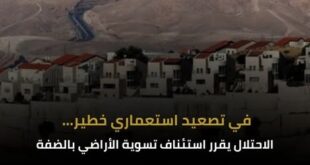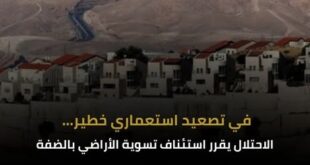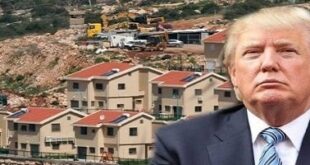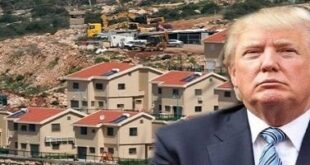By: Madeeha Al-A’raj
The National Bureau for Defending the Land and Resisting Settlements stated in its latest weekly report , that media means and social networking sites reported last week the bombing of a drinking water tank in Rafah by an Israeli force belonging to the 401 brigade, according to official Israeli allegations, the water tank was blown up with explosive devices located in the Tal Al-Sultan Neighborhood, northwest of the city of Rafah, near the areas designated as ‘safe’ by the occupation army. More than once, institutions and municipalities in the Gaza Strip said that the occupation army was deliberately destroying networks, water wells, and desalination plants, causing a severe crisis in providing drinking water to citizens at the height of the war and the peak of summer, with its high and unprecedented temperatures for decades.
This action amounts to a war crime is a common culture prevailing in political circles and the authorities concerned with water issues ‘the government water company “Mekorot” and the Water Unit in the Civil Administration’, and among the settlers, but rather it falls within a context of deprivation. Israelis use water as one of the weapons of war launched against Palestinian citizens under occupation. The policy of using water as a weapon of war against the Palestinians is not new, but it dates back to the first years of the occupation.
In Nov. 1967, the Israeli occupation authorities issued Military Order No. 158, which stipulated that Palestinians were not allowed to construct any new water installations without first obtaining a permit from the Israeli army. Since then, extracting water or developing any new water infrastructure has required obtaining prior permits from the occupation authorities, which is almost impossible.
The Palestinians under occupation are still suffering of the devastating consequences of the order. They are unable to drill new water wells, extend water pumps or deepen existing wells, in addition to being denied access to the Jordan River and fresh water springs. While the occupying state intends to restrict Palestinian access to water, it has developed, through the Israeli water company “Mekorot,” its own infrastructure and water sources in the West Bank for the use of its citizens and settlements.
The state-owned Israeli water company ‘Mekorot’ has also been drilling wells and drawing Spring water located in the occupied West Bank to supply its residents, including those living in illegal settlements, with water for domestic, agricultural and industrial purposes. It is known that the Israeli water company ‘Mekorot’, which was established in 1937 during the era of the British Mandate over Palestine, controls the water sources in Israel, both surface and groundwater. Under the occupation, it exceeded the limits of its work and also controlled the water sources in the West Bank, the Gaza Strip, and the occupied Syrian Golan.
Every summer, a water crisis erupts in a number of Palestinian governorates, which fall under the authority of the Israeli water company ‘Mekorot.’ Among many forms of aggression, the occupation authorities use water as a weapon against the Palestinians in the occupied West Bank; There is a thirst war that affects people, trees and animals. The crisis has worsened since a government of fascists and neo-Nazis took power in Israel, on whom Benjamin Netanyahu depends for his survival in power.
The latest form of this war came in the form of a decision by the Israeli company ‘Mekorot’ to reduce the amount of water allocated to the Hebron and Bethlehem governorates in the interest of increasing the amount of water for the settlements. What is noteworthy is that this water essentially originates from the lands of the West Bank and is stolen by the occupation authorities, controlled and sold to the Palestinian side.
Israel justifies its policy by claiming that it is acting in accordance with the understandings reached within the framework of the interim agreement signed between Israel and the PLO in 1995. It ignores that this agreement is in effect for only 5 years and that the arrangements stipulated in it are far from reflecting the current needs of the Palestinians in the West Bank. Since the signing of the agreement, the population has increased by about 75%, while the amounts of water allocated to the Palestinians have remained the same, despite this, a water crisis erupts every year due to the occupation authorities resorting to reducing the amounts of water allocated to the Palestinians, especially in the Hebron and Bethlehem governorates, and raising it for the settlers.
The Palestinian Water Authority has warned more than once, for example to clarify, that the Israeli company “Mekorot” is continuing its policy of reducing the quantities of water supplied to the main Deir Sha’r water line, which supplies the governorates of Hebron and Bethlehem, as well as the Tarqumiya and Beit Kahil water connections, where the average water quantities decreased to 6,000 cups per day, which means depriving the people of the two governorates of their right to obtain sufficient quantities of water in light of the increasing need and the sharp rise in temperatures within the racist policy of discrimination practiced by the occupation authorities in general, and by the “Mekorot” company in particular towards the Palestinians, which is represented by Discriminating against settlement residents by granting them large additional amounts of water at the expense of Palestinian rights.
The water crisis this year is not limited to the Bethlehem and Hebron governorates, after the unjust reduction decision, but has extended to the Ramallah and Al-Bireh governorates and some areas of Jerusalem, such as Kafr Aqab. Ramallah Governorate is under great pressure to provide increasing water needs in light of the occupation authorities’ refusal to increase the required quantities due to the steady growth in the population. Ramallah and Al-Bireh Governorate ten years ago is not the same as it is today, and despite that, the quantities have remained constant.
Kafr Aqab, which is considered the largest urban area in the Jerusalem Governorate, is also a stark example of the water crisis. Palestinians in Kafr Aqab only get a few hours of water a week, cannot wash clothes or wash the floors and are forced to give up showering, as reported by Haaretz Newspaper According to the latest data, July 2024, the Kafr Aqab area is still suffering from water shortages. The “resident” whose house receives water more than one day a week is considered lucky, according to the aforementioned newspaper, as for tens of thousands of other residents, they only have access to water for 4 – 9 hours a week.
Kafr Aqab has become the place of residence for tens of thousands of Palestinian Jerusalemites, who, according to the occupation law, must pay full municipal taxes, but they do not enjoy municipal services as enjoyed by Jewish settlers in nearby settlements. Even the “Al-Quds Maternity Hospital” in the Kafr Aqab area is facing, according to the hospital director, Taqi Qaisi, a water crisis: “Water is a serious problem in the hospital. We now get water once or twice a week, but even then there is not enough pressure.” “In the pipes, the water cannot flow to the top.”
The Palestinian Jordan Valley, too, is experiencing a stifling water crisis, as the pumping stations belonging to the “Mekorot” company outside the village of “Bardala” are causing the springs in the villages of Ain Al-Bayda and Bardala to dry up completely. In the village of “Al-Auja”, 10 km north of Jericho, a company ‘Mekorot’ dug a well and established a water pumping station near the Wadi al-Auja spring, which provided a large amount of water supplies to the village and the surrounding agricultural lands through a network of irrigation canals, which were now devoid of water. The scene is repeated in the village of Farush Beit Dajan in the central Jordan Valley. The villagers say that they used to have an abundance of water, but the well water has been decreasing more and more in recent years and that the groundwater is depleting due to the Israeli wells that are used to provide water to the neighboring Israeli settlements “Al-Hamra” and “Mihora”.
Thus, the occupation authorities fight the Palestinians over their water and deprive them of it, while opening water taps throughout the day and night in the settlements. In this war on the Palestinians, the occupation authorities, in recent years, have demolished about 500 wells to collect water, destroyed more than 100 springs and springs, and seized more than 52% of Palestinian water in the West Bank, allocating 32% of it to settlements, leaving 16% of their water only for the land owners, according to many international reports, the amount of water consumed by Israelis exceeds the amount consumed by Palestinians living in the occupied Palestinian territories by at least four times.
The average Palestinian per capita consumption of water is 73 liters per day, which is less than the per capita consumption rate recommended by the World Health Organization, which is 100 liters per day. In many herding communities in the West Bank, the average per capita water consumption for thousands of Palestinians reaches only 20 liters per day, according to the United Nations Office for the Coordination of Humanitarian Affairs. In contrast, the average Israeli per capita consumption is about 300 liters per day, while the average for Israeli settlers in the West Bank doubles, according to identical Palestinian and UN data, to more than 7 times the Palestinian per capita consumption.
On the other hand, the settlers continued their acts of orgy and attacks on Palestinian citizens and their property in various governorates of the West Bank, without the occupation army doing anything to prevent these acts of orgy as in the village of Qasra, south of the city of Nablus, 6 citizens were injured by bullets in a series of attacks launched by settlers under the protection of the occupation forces, after they attacked citizens’ homes, which led to the outbreak of confrontations during which the occupation soldiers fired bullets, stun grenades, and tear gas, which led to one citizen being injured by live bullets.
In Masafer Yatta, south of Hebron, settlers from a settlement outpost established on citizens’ lands in the Umm al-Hayman area stormed the village of Khallet al-Dab’a with their livestock and destroyed 80 olive and almond trees, while others set up mobile homes on citizens’ lands near the villages of al-Mufaqara and Sha’b al-Batam, in an attempt to expand a settlement outpost they recently established in the area itself.
In the Wadi Rahal village, south of the city of Bethlehem, a group of settlers attacked citizens while they were working on their land in the Khallet al-Nahla area, and fired live bullets at them, wounding five of them. They also attacked an ambulance and assaulted its crew, while the occupation forces that provided protection for the settlers prevented providing first aid to the injured. Not only that, but they continued acts of orgy and provocation against the citizens while they were on their land in the Al-Makhrour area. They assaulted them and destroyed an agricultural room with the aim of seizing the land, which has an area of about 5 dunums, belonging to citizens who have documents proving their ownership of the land after they won a case from one of the occupation courts confirming their right to the land that was officially registered.
Last week, in the Jericho Governorate, settlers cut off water to the Al-Kaabna community, northwest of the city of Jericho. Others gathered on the road leading to the northern entrance to the city in the Al-Murajat area, and attacked a number of vehicles with stones. The Al-Marajat area extends on the road linking the Ramallah and Jericho governorates, is witnessing continuous and escalating attacks on lands, vehicles, and Bedouin communities with the aim of displacing them, with the encouragement of the Minister of Settlement in the Ministry of the Occupying Army, Smotrich, and the Minister of National Security, Ben Gvir, in clear exploitation of the brutal conditions of the war being waged by the occupation forces on the Gaza Strip.
List of Israeli Assaults over the Last Week Documented by the National Bureau:
Jerusalem:
- Demolishing an agricultural room in Jabal al-Mukaber, while settlers attacked the town of Hizma in the “Al-Kharaba” area on the eastern side of the town. They attacked citizens’ homes and property and uprooted a number of trees amidst live bullets. The residents confronted them without any injuries being reported.
- Bulldozing the land of the Alyan family in Beit Safafa, demolished a stone chain, and bulldozed and uprooted trees to carry out settlement construction on the land. They also demolished a two-story house and four shops located in the area between the towns of Beit Anan and Beit Leqia, belonging to Jerusalemites.
Hebron:
- Invading the Beit Awa town, accompanied by their heavy machinery, and demolished a barn, a water well, and the floor of an agricultural greenhouse, and uprooted “tomatoes and cucumbers” crops and trees belonging to the citizen Rasem Mustafa Al-Suwaiti.
- Writing racist slogans against Palestinians and Arabs on a number of vehicles in a garage belonging to the Salhab family in Khirbet Qalqas, south of the city of Hebron.
- Demolishing a barn, an agricultural greenhouse floor, and a water well, and uprooted trees and crops in the town of Beit Awa belonging to the citizen Rasem Mustafa Al-Suwaiti.
- Invading the village of Al-Tabban and handed the citizen Aziz Hamid Al-Hamamdeh a notice to demolish an old health unit, and handed the citizen Issa Muhammad Al-Hamamdeh a notice to demolish a sheep barn, a room, agricultural areas and photographed residential rooms, barracks, tents and health units for citizen Nasser Abu Obaid in the same village in Musafer Yatta.
Ramallah:
- Blowing up the house of prisoner, Murid Mahmoud Dahadha in the town of Atara, north of Ramallah, which is a house under construction located on the third floor of a three-story residential building, and blew up parts of the other two floors that belonged to his brother and his family. I
- Attacking the Yarqa village from the western side, Citizens confronted them, without any casualties.
Nablus:
- Demolishing a four-story house on the western side of the village of Duma, belonging to citizen Mamoun Dawabsha.
- Burning dozens of olive trees in the village of Madama, south of Nablus. The Palestinian Red Crescent Society reported that its crews dealt with the injury of a 62-year-old man, as a result of settlers beating him and spraying him with pepper gas near the town of Huwwara, then admitted to the Ibn Sina Emergency Center in the town.
- military purposes in an area that is only 150m away from citizens’ homes, and notified the residents of the 7-day objection period.
Jordan Valley:
- Stealing 25 cows from Khirbet Yarza, east of Tubas, belonging to the citizen Fawzi Mahmoud Anbousi, aassaulted farmers in the Ein al-Hilweh area in the northern Jordan Valley, prevented them from reaching the water spring in there.
- Attacking a young man in the Arab Al-Malihat community, northwest of Jericho.
 المكتب الوطني للدفاع عن الارض ومقاومة الاستيطان منظمة التحرير الفلسطينية
المكتب الوطني للدفاع عن الارض ومقاومة الاستيطان منظمة التحرير الفلسطينية




